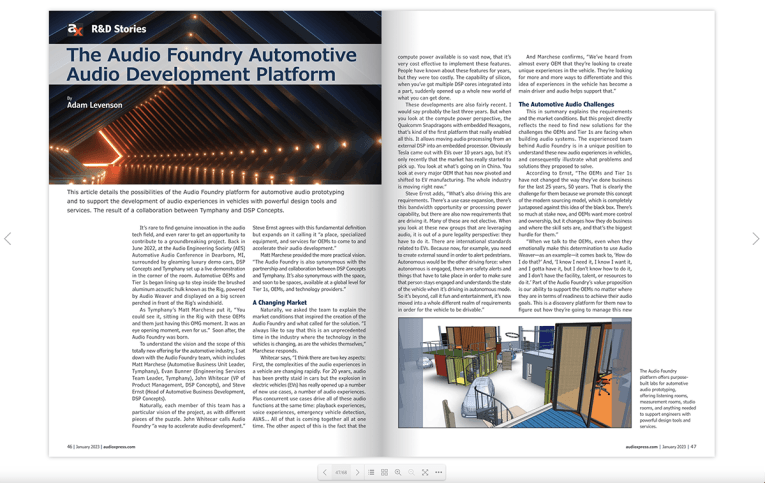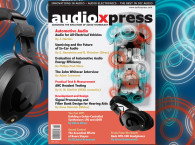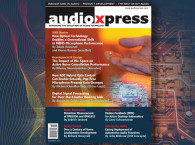 Dream it! Plan it! Prototype it! Feel it in your bones! audioXpress January 2023 offers multiple perspectives to inspire you in the new year.
Dream it! Plan it! Prototype it! Feel it in your bones! audioXpress January 2023 offers multiple perspectives to inspire you in the new year. In this first issue of audioXpress for 2023, there's a wide range of articles to meet all interests, products, and application segments. As promised, we have the latest industry insights in our Market Update on Bone Conduction Transducers, as our great cover - featuring the Haylou PurFree bone conduction earphones - suggests, perfectly illustrating our focus for this month.
Bone conduction technology is seeing increasing usage, evolving from its origins in medical hearing devices to mainstream consumer and strategic communication applications. The advantages in open-ear wireless applications are generating increasing appeal and the audio industry is responding. In "Bone Conductors Going Mainstream," Mike Klasco and J. Martins explore the evolution in transducers and product designs that use bone conducted vibrations transmitted directly to the human skull and skin, and the advantages of having the ears remaining open, allowing us to have a parallel hearing channel to our surroundings, while still enjoying music or making calls. In order to compete with traditional earphones in music fidelity, this technology still has some way to go. Yet the key proposition in bone conduction is already appealing to a significant number of consumers and professionals. This article traces the evolution in this field.
Complementing the wider perspective on drivers and transducers, the January 2023 issue of audioXpress also features a fascinating article on "The Science Behind the Taction Transporter," by Silmon J. Biggs and John Steinberg. In "Building an Haptic Dimension," the two masterminds behind Taction Technology share the story of the development of the Transporter, a patented transducer that delivers faster, accurate bass and is designed to work with the main audio driver in headphones. As haptic motors are finding applications in gaming, music, VR/AR, and therapeutic/wellness, the Transporter subtly vibrates against the user's skin to produce an extra dimension that can be described as an high-fidelity extension.

Our next article looks at the Practical Test & Measurement angle of bone conduction technology, as used in product development for headsets and in-ear devices. While bone conduction technology offers new possibilities for manufacturers to better evaluate device performance, no appropriate test equipment and methods were commercially available until now. In "The Benefits of Using Structure-Borne Sound in Headset Signal Processing," Hans Gierlich details HEAD acoustics' approach, complementing a Head-and-Torso Simulator (HATS) with an actuator capable of generating structure-borne sound in the artificial ear. This way, a realistic simulation of the human structure-borne voice signal for in-ear headsets is possible.
In his column Sound Control, Richard Honeycutt expands this issue's perspective to the topic of "Acoustical Test Sources." The choice of a sound source for acoustical testing and reporting is decisive and should be determined according to the applications. In his article, Honeycutt identifies different types of acoustical testing and explores the science behind the choice of a sound source for that purpose, as he explores the characteristics and benefits of available sources for acoustical measurements.
The January 2023 issue of audioXpress also contains a contributed article by Andrew Bellavia, who recently began a new chapter in his career as industry consultant with Aurafuturity, providing expert advice in hearables, hearing health, and promoting hearing care innovation. In his article "OTC Hearing Aids: Is Innovation Leaving the Rule Behind?" Bellavia offers a knowledgeable perspective on the Over-the-Counter (OTC) hearing aid applications and their potential implications. As a wave of new developments promises to solve the most pressing need for people with milder hearing loss, allowing mass-market hearables to supplant OTC hearing aids with less stigma, he suggests the FDA’s OTC hearing aid rule (October 2022) includes assumptions that are quickly becoming obsolete as recent developments illustrate. A must read.

And from transducers, acoustical testing, and hearing aids, this issue moves on to the cutting-edge perspectives of automotive audio development, as Adam Levenson introduces the new Audio Foundry platform, resulting from a collaboration between Tymphany and DSP Concepts. Through the testimony of four key executives from both companies, the article details the possibilities of the Audio Foundry platform for automotive audio prototyping and to support the development of audio experiences in vehicles with powerful design tools and services. The genesis of this groundbreaking project happened in June 2022, at the Audio Engineering Society (AES) Automotive Audio Conference in Dearborn, MI, where DSP Concepts and Tymphany set up a live demonstration that immediately appealed to the automotive OEMs and Tier 1s in attendance. The acoustic sandbox structure, known as the Rig, powered by Audio Weaver, was an eye-opening moment for everyone, including for the promoting companies. Soon after, the Audio Foundry was born.
And to start the year with much more valuable content for our readers, audioXpress is extremely proud to start publishing a new series of articles on Simulation Techniques by René Christensen (BSEE, MSc, PhD), a recognized expert on the topic and renowned resource for the audio industry. In his first contributed article, Christensen offers a valuable tutorial that discusses the unique possibilities of three-dimensional analysis of loudspeaker driver displacement, using Phase Decomposition and Axial-Symmetrical Decomposition techniques.
And finally, for all our readers following the fascinating series on Power Transformers by Chuck Hansen, this January 2023 issue of audioXpress includes a third article exploring transformer insulation materials and winding bobbins, and testing methods for the insulation system. In the previous two articles in this series, Chuck Hansen detailed the history of transformer cores and their various construction methods, and now we're getting to some fascinating details about commercial transformers.

As the new year approaches, this is also the ideal time to commit or renew your subscription, because audioXpress is only going to get better. Subscribing to the digital online version allows immediate access and is available here: www.audioxpress.com/page/audioXpress-Subscription-Services.html
If you wish to buy a single printed issue or the complete audioXpress archive on USB, from 2000 to 2022 (yes, including the latest issue), just visit our online shop at www.cc-webshop.com
Don't miss out, get your copy of audioXpress right now at www.gotomyxpress.com






